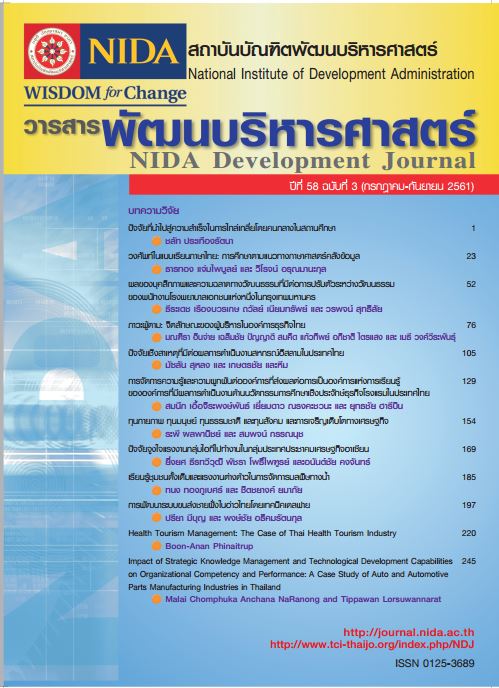Physical Capital, Human Capital, Natural Capital, Social Capital and Economic Growth
Physical Capital, Human Capital, Natural Capital, Social Capital and Economic Growth
Keywords:
Transaction Cost, Corruption, Capital Accumulation, Abundance of Capital, Depreciation of Social CapitalAbstract
Economic growth is created from demand for improvement of living conditions and servicesto increased human population. Factors for economic growth are accumulation of 4 types of capital which are complementary, comprising human capital, physical capital, social capital, and natural capital. Deficiency of any one can compromise economic growth and erodes supply of other types of capital. Abundance of human capital and natural capital is behind abundance of physical capital which drives economic growth. On the other hand, abundance of physical capital creates climate for accumulation of human capital and wise use of natural capital. Social capital is crucial for healthy economic transactions and wise use of natural capital which is behind sustainable economic growth.
References
Bjørnskov, C. (2003). Corruption and Social Capital. Aarhus School of Business. Retrieved July 31, 2014 from http://www.hha.dk/nat/workshop/2003/CHBJ2001.pdf
Bose, N., Capasso, S., & Murshid, P., A. (2008). Threshold Effects of Corruption: Theory and Evidence. World Development, 36 (7), 1173-1191. Retrieved November 23, 2013 from http://www.elsevier.com/locate/ worlddev. Doi:10.1016/j.worlddev.2007.06.022
Dixon, P. B., Parmenter, B. R., Sutton, J., & Vincent, D. P. (1982). ORANI: A Multisectoral Model of the Autralian Economy. New York: North-Holland Publishing Company.
Hardin, G. (1968). The Tragedy of the Commons. Science New Series, 162(3859), 1243-1248. Retrieved October 17, 2014, from http://www.geo.mtu.edu/~asmayer/rural_sustain/governance /Hardin%201968.pdf
Hanousek, J., & Kochanova, A. (2015). How does corruption affect economic growth?.World Economic Forum. Retrieved May 18, 2015, from http://agenda.weforum.org/2015/05/how-does-corrpution-affect-economic-growth
Hawken, P., Lovins, A. B., &Lovins, L. H. (1999). Natural Capitalism: Creating the Next Industrial Revolution. Little, Brown & Company. ISBN: 978-0-316-35316-8
Johnson, P. M. (2005). Transaction costs: A Glossary of Political Economy Terms. Auburn University. Retrieved January 30, 2013, from http://www.auburn.edu/ ~johnspm/gloss/transaction_costs
Kaplan, R., S., & Norton, D., P. (1992). The Balanced Scorecard - Measures That Drive Performance. Harvard Business Review, (January–February), 71–79.
Lovelock, J. E. (1988). The Ages of Gaia. New York: W.W. Norton Co., Inc.
Maslow, A. H. (1943). A Theory of Human Motivation. Psychological Review, 50 (4), 370–96.
McColgan, P. (2001). Agency theory and corporate governance: a review of the literature from a UK perspective. Working paper, May 22, 2001. Glasgow: Universiteit van Strathclyde. Retrieved June 6, 2013 from http://www.ppge.ufrgs.br/giacomo/arquivos/gov-corp/mccolgan-2001.pdf
Ostrom, E. (2009). Beyond Markets and States: Polycentric Governance of Complex Economic Systems. Prize Lecture, December 8, 2009. Retrieved January 14, 2015 from http://www.nobelprize.org/nobel_prizes/economic-sciences/laureates/2009/ostrom_lecture.pdf
Page, J. (1994). The East Asian Miracle: Four Lessons for Development Policy. NBER Macroeconomics Annual 1994, 9, 219–269. MIT Press. Retrieved on October 10, 2014, from http://www.nber.org/ chapters/c11011.pdf. ISBN9780262560801
Putnam, R. D. (1993). Making Democracy Work: Civic Traditions in Modern Italy. Princeton University Press.
Romer, M. P. (1989). Human Capital and Growth: Theory and Evidence. National Bureau of Economic Research, NBER Working Paper No. 3173. Retrieved on March 31, 2014 from http://www.nber.org/ papers/w3173
Swan, T. W. (1956). Economic Growth and Capital Accumulation. The Economic Record, 32 (2), 334-361.
Solow, R. M. (1956). A Contribution to the Theory of Growth Theory. The Quarterly Journal of Economic, 70 (1), 65-94. Retrieved March 23, 2016 from http://link.jstor.org/sici?sici=0033-5533%28195602%2970%3A1%3C65%3AACTTTO%3E2.0.CO%3B2-M
Thomas, V., Dailami, M., Dhareshwar, A., Kaufmann, D., Kishor, N., Lopez, R., & Wang, Y. (2000). The Quality of Growth. New York: Oxford University Press. ISBN: 0-19-521593-1
Downloads
Published
How to Cite
Issue
Section
License

This work is licensed under a Creative Commons Attribution-NonCommercial-NoDerivatives 4.0 International License.





